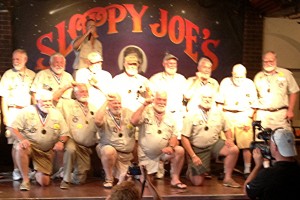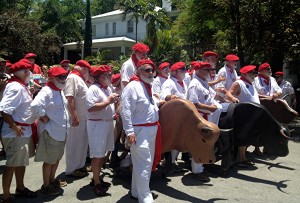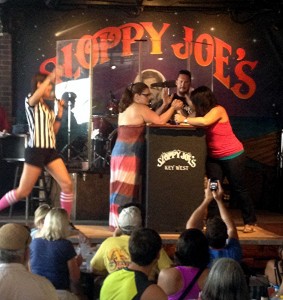Ernest Hemingway wrote 16 novels and 49 short stories. Five of his works were made into movies and The Old Man and the Sea earned a Pulitzer Prize in 1953. Hemingway lived what he wrote. He was a Red Cross ambulance driver in Italy during WWI, a war correspondent during WWII and the Spanish Civil War, lived as an expatriate American writer in 1920s Paris, and was a champion fisherman and African hunter. His travels, experiences, and his descriptive writing style gave his stories the feeling of places exotic, dangerous, romantic, and far away. He told interesting and often tragic human tales interwoven with basic values. He won the Nobel Prize for Literature in 1954.
His July 21 birthday is observed each year in Key West. Events of “Hemingway Days” go on for most of a week and draw participants from all over the US and a few foreign countries.
Anglers compete for $50,000 in prizes fishing for marlin, spearfish, dolphin, tuna, and wahoo in the Key West Marlin Tournament. An awards banquet caps three full days of fishing in Gulf waters Hemingway regularly traveled in his boat Pilar when he lived in Key West 1931-1939.
The most popular event is the Hemingway look-alike contest. This year’s was the 33rd annual sponsored by the Hemingway Look-Alike Society and 177 gentlemen dressed in khaki and sporting fluffy white beards showed up (though one dressed as a dashing young Hemingway this year) to take a run at being named “Papa 2013.”
 The competition took place on stage at Sloppy Joe’s Bar at 201 Duval Street. To present their qualifications, contestants sang songs, told jokes, did dramatic recitations, gave prepared speeches, and frequently rambled on in disorganized fashion until the microphone went dead at the time limit. Former contest winners served as judges who gradually winnowed the field to 25, then five, then named the final winner over the course of three evenings. Some contestants have been doing this for 10-15 years. It’s not about winning, they say; it’s a week of hanging about drinking and swapping tales with the same bunch of guys year after year.
The competition took place on stage at Sloppy Joe’s Bar at 201 Duval Street. To present their qualifications, contestants sang songs, told jokes, did dramatic recitations, gave prepared speeches, and frequently rambled on in disorganized fashion until the microphone went dead at the time limit. Former contest winners served as judges who gradually winnowed the field to 25, then five, then named the final winner over the course of three evenings. Some contestants have been doing this for 10-15 years. It’s not about winning, they say; it’s a week of hanging about drinking and swapping tales with the same bunch of guys year after year.
Other activities include a “Hemingway in Key West” exhibit at the Customs House Museum, an evening of readings from local authors, the Key West Poetry Guild reading Hemingway’s poetry at the Blue Heaven Bar, “For Whom the Bell Tolls” playing at a local theater, the Hemingway home tour, a dockside fishing contest for Papa contestants, the annual Lorian Hemingway short story competition, a Caribbean street fair, and, of course, the running of the bulls. Dressed in traditional white bullfighting attire with red berets and sashes, Papa wanna-bes push wooden bulls on wheels through the streets while hundreds of people follow taking pictures.
playing at a local theater, the Hemingway home tour, a dockside fishing contest for Papa contestants, the annual Lorian Hemingway short story competition, a Caribbean street fair, and, of course, the running of the bulls. Dressed in traditional white bullfighting attire with red berets and sashes, Papa wanna-bes push wooden bulls on wheels through the streets while hundreds of people follow taking pictures.
 Events conclude with the arm-wrestling contest offering men’s, women’s, and Papa’s divisions. Some participants are serious body builders; some are just there for fun. The best to watch is the occasional hand-to-hand combat between women in long dresses and strappy high heels.
Events conclude with the arm-wrestling contest offering men’s, women’s, and Papa’s divisions. Some participants are serious body builders; some are just there for fun. The best to watch is the occasional hand-to-hand combat between women in long dresses and strappy high heels.
Key West is hot and humid in July. The only prudent thing for the casual tourist to do is to walk from place to place, from museum to T-shirt shop to art gallery to restaurant to cigar store to bar, then on to another bar seeking cool air and a place to sit down. Ample fresh mussels, oysters, conch and other seafood with accompanying drinks are readily available to make the experience worthwhile.
But finding an authentic drink that Hemingway regularly enjoyed is another matter. A “historic” sign on Duval Street proclaims that Hemingway brought the mojito to Key West in the 1930s. According to Philip Greene in his book To Have and Have Another, there’s no evidence Hemingway ever had a mojito. Hemingway didn’t like sweet drinks because of his diabetes, and no character in his stories ever drinks one.
His characters do drink a frequent Bloody Mary, Cuba Libre, Gimlet, Gin & Tonic, Martini, Tom Collins, Whiskey Sour, and White Lady among others (but never a Margarita) and Key West bartenders are happy to make you one. But if you seek authenticity, ask for a Hemingway Special. A variation on the Daiquiri, it contains rum, grapefruit and lime juice, and maraschino liqueur and was originally crafted specifically for Ernest Hemingway at the Floridita Bar in Havana in 1937. Or, order a Papa Dobles, the same cocktail but a double.
_______________
Greene, Philip. To Have and Have Another. New York: Penguin Group, 2012.
